Abstract
Fusarium roseum 'Graminearum' was isolated from overwintered oats in Alaska and was tested for its ability to cause tibial dyschondroplasia (TDP) in broiler chickens. The water-soluble fraction was tested and found to cause TDP. In addition, diacetoxyscirpenol and 7-hydroxydiacetoxyscirpenol were identified in the acetonitrile fraction of the extracts and caused mild mouth lesions in chickens. Six major water-soluble components were purified by thin-layer chromatography and tested for toxicity to chick embryos. One of the six components, called TDP-1, was found to be lethal to chick embryos. There was a 100% incidence of TDP in chickens fed a diet containing 75 ppm (wt/wt) of pure TDP-1, thus establishing the cause and effect relationship between TDP and TDP-1. Analyses by thin-layer chromatography and mass spectrometry revealed that TDP-1 is polar and ninhydrin positive, exhibits fluorescence with UV irradiation, and is a nitrogen-containing component with an empirical formula of C15H20N2O4.
Full text
PDF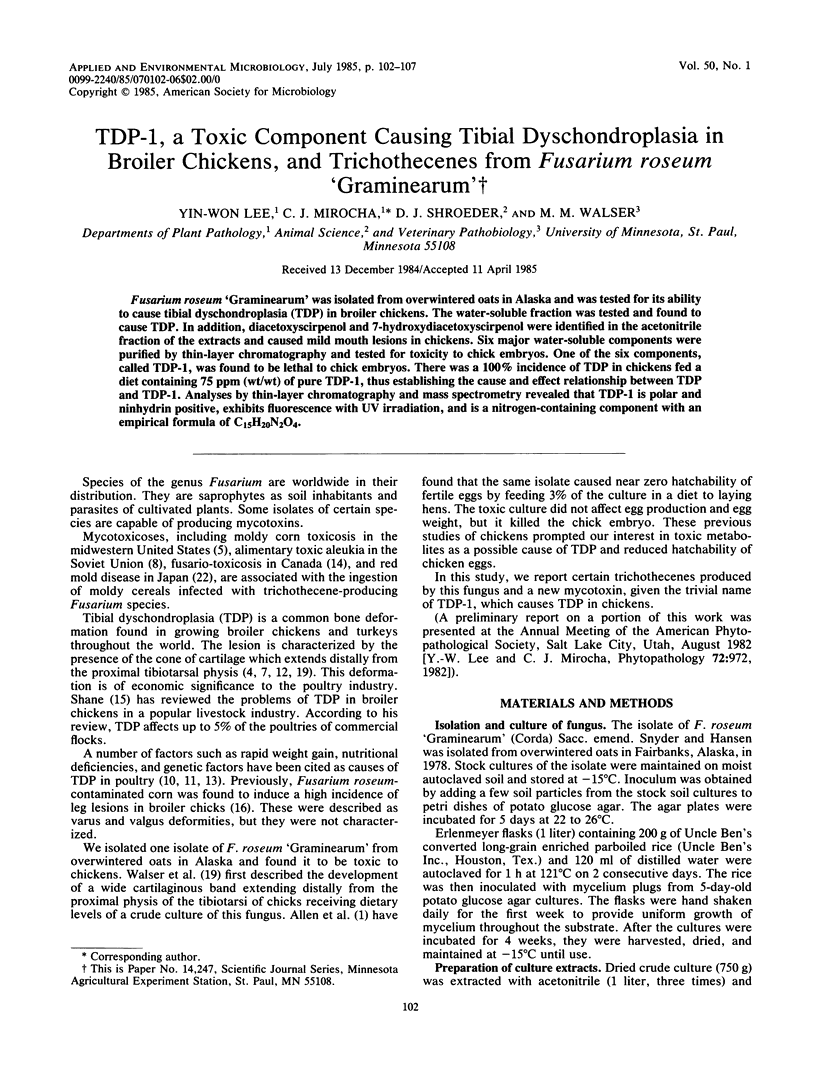
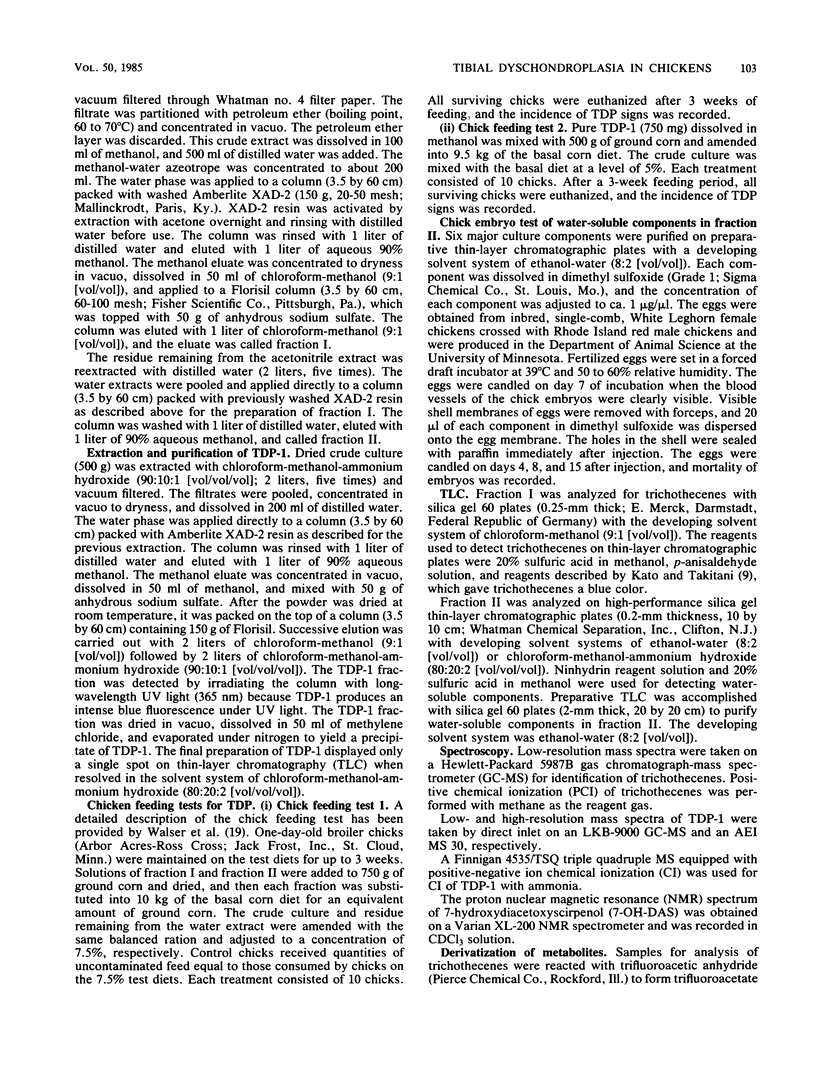
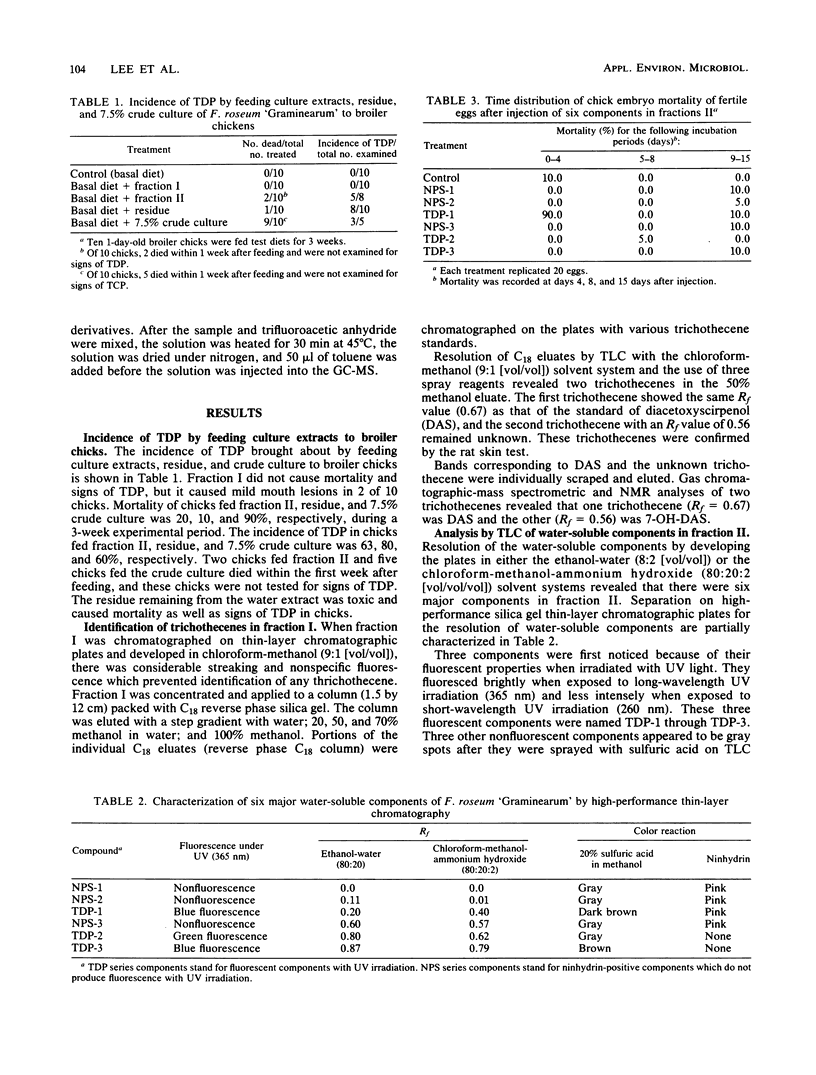
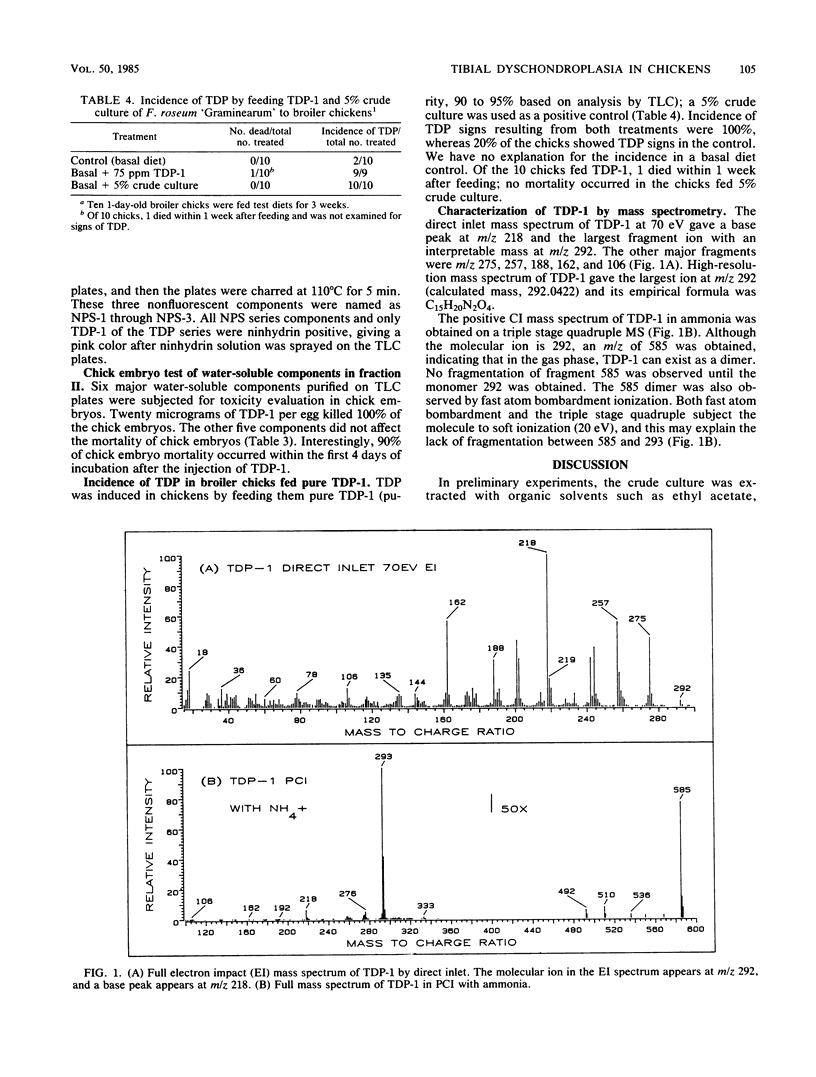
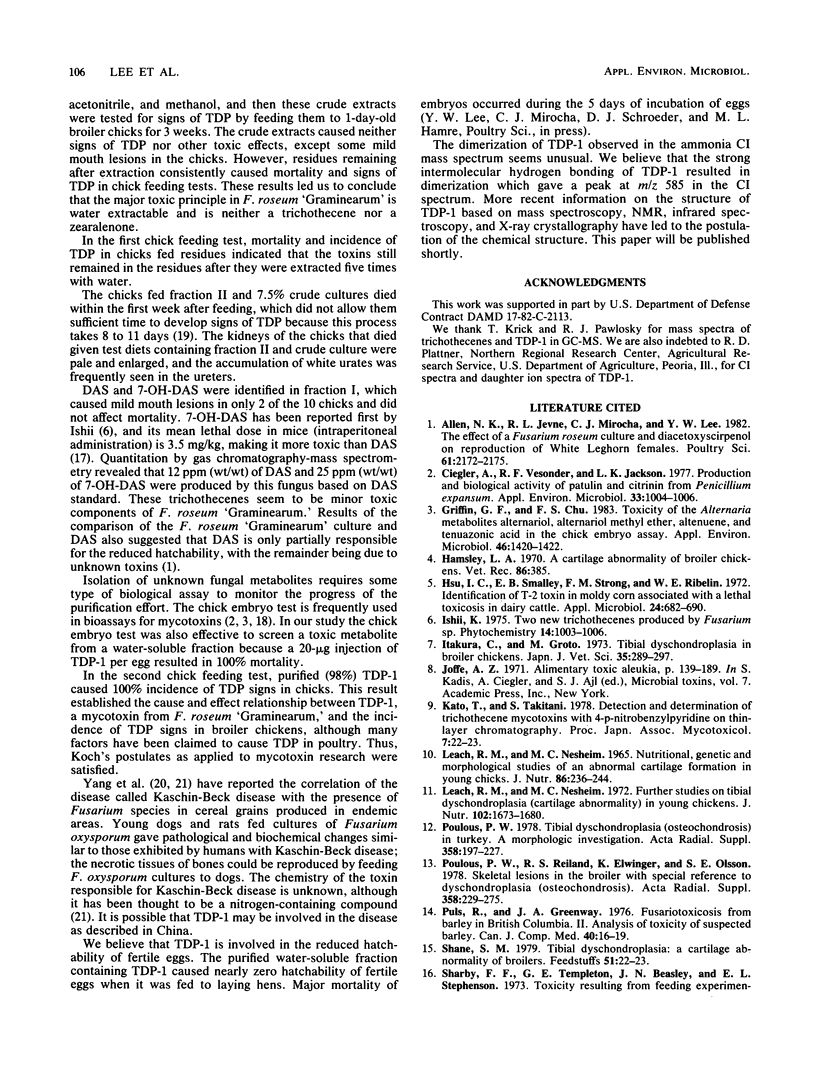
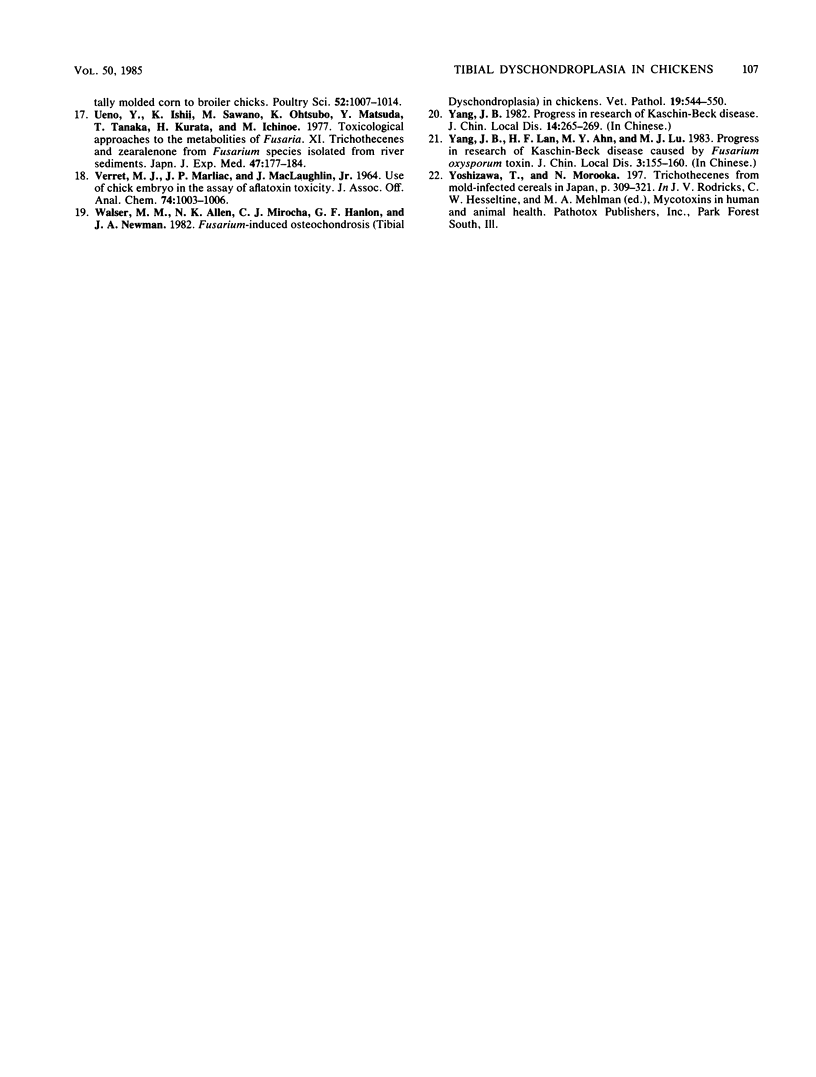
Selected References
These references are in PubMed. This may not be the complete list of references from this article.
- Allen N. K., Jevne R. L., Mirocha C. J., Lee Y. W. The effect of a Fusarium roseum culture and diacetoxyscirpenol on reproduction of White Leghorn females. Poult Sci. 1982 Nov;61(11):2172–2175. doi: 10.3382/ps.0612172. [DOI] [PubMed] [Google Scholar]
- Ciegler A., Vesonder R. F., Jackson L. K. Produciton and biological activity of patulin and citrinin from Penicillium expansum. Appl Environ Microbiol. 1977 Apr;33(4):1004–1006. doi: 10.1128/aem.33.4.1004-1006.1977. [DOI] [PMC free article] [PubMed] [Google Scholar]
- Griffin G. F., Chu F. S. Toxicity of the Alternaria metabolites alternariol, alternariol methyl ether, altenuene, and tenuazonic acid in the chicken embryo assay. Appl Environ Microbiol. 1983 Dec;46(6):1420–1422. doi: 10.1128/aem.46.6.1420-1422.1983. [DOI] [PMC free article] [PubMed] [Google Scholar]
- Hsu I. C., Smalley E. B., Strong F. M., Ribelin W. E. Identification of T-2 toxin in moldy corn associated with a lethal toxicosis in dairy cattle. Appl Microbiol. 1972 Nov;24(5):684–690. doi: 10.1128/am.24.5.684-690.1972. [DOI] [PMC free article] [PubMed] [Google Scholar]
- Itakura C., Goto M., Fujiwara Y. Tibial dyschondroplasia in broiler chickens in Japan. Nihon Juigaku Zasshi. 1973 Aug;35(4):289–297. doi: 10.1292/jvms1939.35.289. [DOI] [PubMed] [Google Scholar]
- LEACH R. M., Jr, NESHEIM M. C. NUTRITIONAL GENETIC AND MORPHOLOGICAL STUDIES OF AN ABNORMAL CARTILAGE FORMATION IN YOUNG CHICKS. J Nutr. 1965 Jul;86:236–244. doi: 10.1093/jn/86.3.236. [DOI] [PubMed] [Google Scholar]
- Leach R. M., Jr, Nesheim M. C. Further studies on tibial dyschondroplasia (cartilage abnormality) in young chicks. J Nutr. 1972 Dec;102(12):1673–1680. doi: 10.1093/jn/102.12.1673. [DOI] [PubMed] [Google Scholar]
- Poulos P. W., Jr, Reiland S., Elwinger K., Olsson S. E. Skeletal lesions in the broiler, with special reference to dyschondroplasia (osteochondrosis). Pathology, frequency and clinical significance in two strains of birds on high and low energy feed. Acta Radiol Suppl. 1978;358:229–275. [PubMed] [Google Scholar]
- Puls R., Greenway J. A. Fusariotoxicosis from barley in British Columbia. II. Analysis and toxicity of syspected barley. Can J Comp Med. 1976 Jan;40(1):16–19. [PMC free article] [PubMed] [Google Scholar]
- Sharby T. F., Templeton G. E., Beasley J. N., Stephenson E. L. Toxicity resulting from feeding experimentally molded corn to broiler chicks. Poult Sci. 1973 May;52(3):1007–1014. doi: 10.3382/ps.0521007. [DOI] [PubMed] [Google Scholar]
- Ueno Y., Ishii K., Sawano M., Ohtsubo K., Matsuda Y. Toxicological approaches to the metabolites of Fusaria. XI. Trichothecenes and zearalenone from Fusarium species isolated from river sediments. Jpn J Exp Med. 1977 Jun;47(3):177–184. [PubMed] [Google Scholar]
- Walser M. M., Allen N. K., Mirocha C. J., Hanlon G. F., Newman J. A. Fusarium-induced osteochondrosis (tibial dyschondroplasia) in chickens. Vet Pathol. 1982 Sep;19(5):544–550. doi: 10.1177/030098588201900509. [DOI] [PubMed] [Google Scholar]


